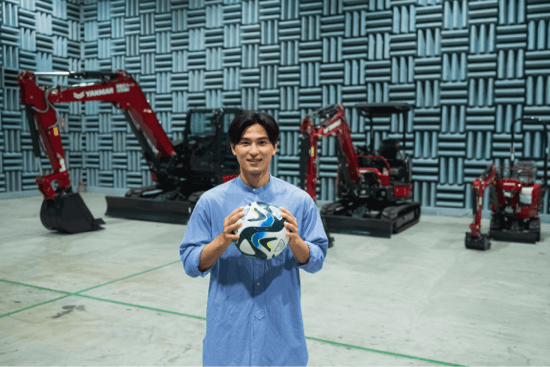




What Kinds of
Construction Machinery
Do Cities Need?
Takumi Minamino,
Professional Football
Player:Piloting
Machinery and Playing
Football With It
Construction equipment. Specifically, compact construction machinery. Minamino has learned that this sector is a major focus of Yanmar.
※ The previous article is here.
The trend toward urbanization will lead to fewer large development projects and more renovation and maintenance projects instead. Compact construction machinery will be a key asset for such operations.
Some staff in the Yanmar R&D team are about to lead Minamino further into the world of construction machinery technology.
Refinements to noise reduction technology: Making compact construction machinery an accepted part of our streets
“When you think about construction machinery, what’s the first thing that comes to mind?”
asks Yoshihiro Hayami, a member of Yanmar’s R&D Department.
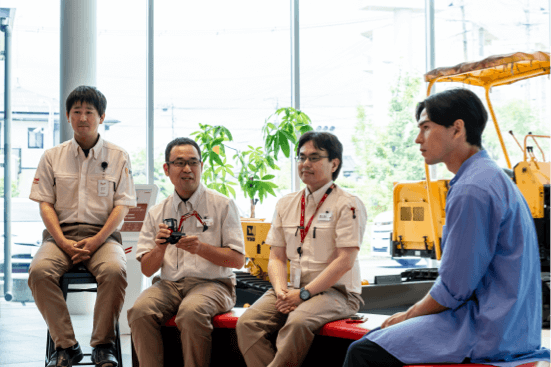
“Probably something noisy and annoying, right?” Minamino nods.
“Yes, that’s what comes to mind. Where I come from, the farmers are often working with agricultural machinery in the rice fields. It’s almost impossible to hold a conversation when I walk past them. If agricultural machinery is that noisy, surely construction machinery is even louder.”

“When construction machinery is chosen for work in the city, low noise is important.”
Hayami begins his explanation using the model of an excavator.
“Yanmar’s construction machinery, as I’ve mentioned, is characterized by its compact size. If we put the engine, hydraulic system and other parts into such a compact frame, there’ll be little room left for noise reduction measures. Although we add materials for noise absorbing and vibration damping, we can’t use that much. So we have to come up with a variety of innovations to get noise levels as low as possible. The fans cooling the radiator are just one source of noise. We tune the machine to strike the optimum balance between heat and noise to minimize noise generation. It’s improvements like these that we go looking for.”
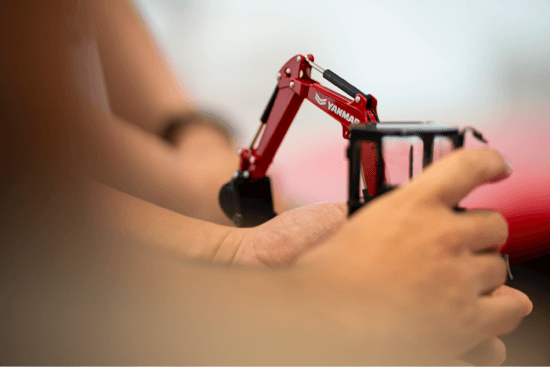
“The more it works, the hotter it gets, eh. Just like in sports,” says Minamino, gaining a deeper understanding of the technology. There is a tradeoff between performance and low-noise countermeasures (i.e., a temperature-to-performance tradeoff). Yanmar’s engineers have a growing mine of experience using technology to navigate this tradeoff.
One result of their trial and error is the ViO80-7, which the company released in June this year. This model offers 19% greater engine power at half the noise level, compared with its previous iteration –- a giant step forward for construction sites in residential and urban districts.
“So… a substantial increase in power for half the noise level. Wait, what?”

“So, would you like to hear how the engine sounds?”
Minamino nods, obviously curious.
Will Yanmar’s newest machine let out a racket?
Or a whisper?
“What kind of place is this!? Wait, my voice sounds kinda weird…”
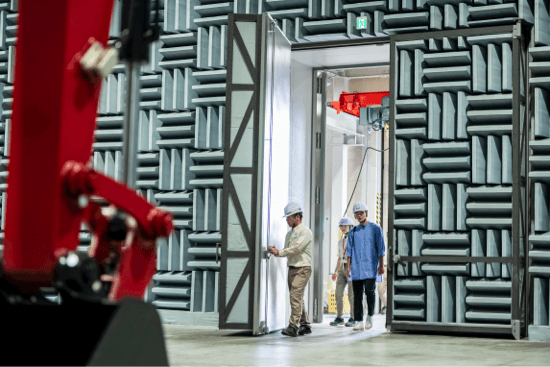
Minamino is being shown about the semi-anechoic chamber inside the research facility. This chamber, large enough even for heavy construction machinery, is one of the biggest of its kind in Japan. Engineers bring construction machinery into this chamber and conduct noise tests night and day.
At the moment, five pieces of construction machinery have been placed in the chamber, from compact construction machinery that is no taller than a person to a large item that can be considered heavy construction machinery.
To acclimatize his ears in this strange environment, where silence rules, Minamino walks about, then speaks showing his keenness.
“Ah, if I’m not wrong, this mesh here is for thermal regulation, right? You mentioned it in your explanation just now.”
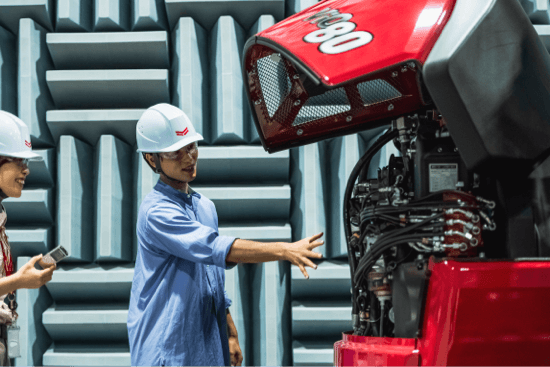
The air intake port at the side of the ViO80-7 has caught Minamino’s eye. Actually, it is this very component that makes the ViO80-7 quieter. Earlier construction machinery uses an “exhaust-based system,” where, as the name implies, heat from within the machine is exhausted to the external environment. Although these machines have the advantage of allowing for inexpensive construction, they have the disadvantage of being noisier because of their larger exhaust port.
In contrast, the intake-based system uses a small air intake port. The system not only reduces noise but also increases cooling efficiency. It’s a high-performance system.
Minamino looks over every nook and cranny, peering even under the hood. After circling the machine and examining the design, it’s time to climb on board. Compared with the agricultural equipment that he rode on for his previous reporting, this machinery body is quite a bit bigger.
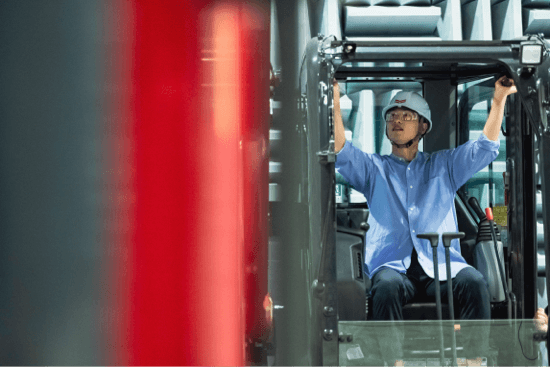
Minamino turns the key after learning how to start the engine. The sound of the engine reverberates across the chamber, breaking the silence.
That sudden sound shocks Minamino, but with his ears already acclimatized to the silence of the chamber, that was but for a moment. The machine isn’t loud enough for one to say “Hey, that’s noisy.” In fact, Yanmar staff around the machine can easily explain its operation to Minamino, who is holding the joystick. All without raising their voices.
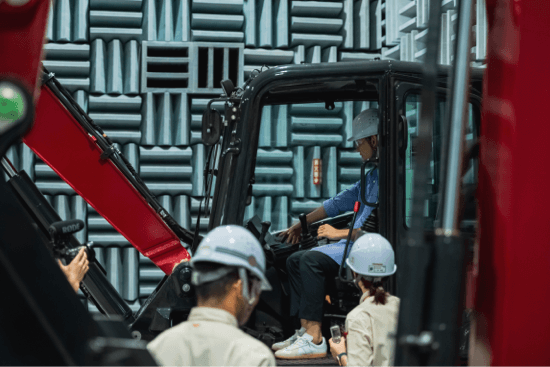
When asked about his impression after getting off the ViO80-7, Minamino replied in a cheery voice. “It was quieter than I thought. It was really surprising. The people on the ground and I could converse with each other and get our message across. And to think that it is also more powerful! Athough I can’t verify that because I can’t be digging any holes here!” That day, he experienced how such construction machinery is very suitable for use in areas where houses and other buildings are clustered tightly together.
Interacting with smart construction machinery
Minamino continued trying out other construction machinery in the semi-anechoic chamber.
Sitting on the SV08, a signature product representing Yanmar’s compact construction machinery, he said, “The operation is so intuitive. It’s such a straightforward vehicle. And more than that, its narrow width is really something. It can go into a house or a plastic greenhouse through the door. It can enter and operate in all sorts of places.” The small size was a fun surprise.
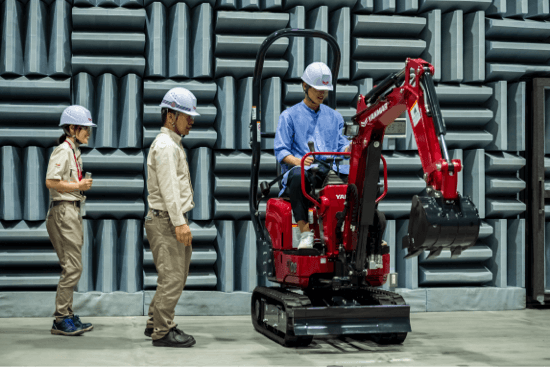
He also rode the ViO30, a next-generation, ICT-equipped piece of construction machinery. The machine’s system automatically manipulates the dozer blade using 3D data, and even a novice operator can use it for high-precision grading.
On that day, Minamino also embarked on a challenge as part of the demonstration. A tape measuring 10 meters or so was stretched out at a slight incline, and he was to see for himself how accurately the blade would rise while the machine was moving forward. He tried out both manual and automatic modes to see how they differed.
“In manual mode it’s not easy. I can really feel how it’s all but impossible for someone with little experience to maintain the machine’s speed while leveling the ground. But in automatic mode, productivity would really go up.”
Construction work in the future will gradually become a joint effort between human and machine. To allow Minamino to have a deeper sense of what that means, the staff at Yanmar invited him to do something seemingly ridiculous:
“Wanna play football with the construction machine?”
“Sure, I’m up for it!”
Minamino then experiences for himself how nimbly this piece of compact construction machinery can move.
Next-generation construction machinery
for a sustainable world
Hayami, from the R&D Department, had a question for Minamino, who had just had a hands-on experience with ICT-equipped construction machinery. That type of machine will make the construction industry more sustainable, and cities more sustainable as well.
“Do you own a car?”
He answered that he had a hybrid. Then reflecting his R&D experience, Hayami says, “As we head toward a sustainable future, Yanmar Construction Equipment still has challenges to address. One of them is electrification.”
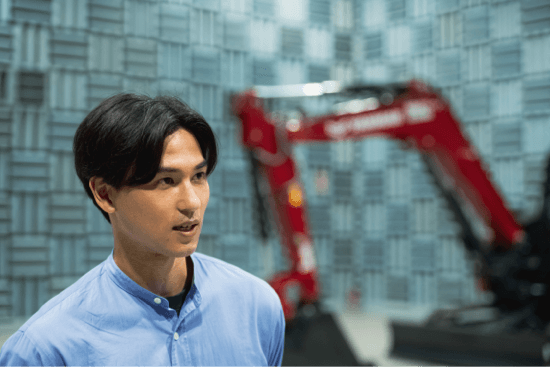
Yanmar is giving itself until 2050 to surmount various challenges in a bid to realize its vision, “A Sustainable Future.”
Another challenge is reducing greenhouse gas emissions. A look at Yanmar's business operations shows that 90% of CO2 emissions come from customers who use the company’s products, especially agricultural and construction machinery. There is an urgent need to cut emissions, so in addition to improving the efficiency of its engines and hydraulic systems, Yanmar is also developing electric construction machinery powered by lithium-ion batteries.
Hayami continued his explanation, but not before prefacing it by saying that Minamino might be more familiar with the situation.
“In Western countries such as the UK, France, Germany and Spain, vehicles that fail to meet emissions standards are essentially banned from importation. In such countries, you will be taxed if you try to bring them in.”
Although there are no emissions regulations for construction machinery at present, it is simply a matter of time before they are introduced.
Feeling apprehensive about the future, Minamino remarked, "I never realized that the backlash against exhaust emissions was so intense..." To this, a technician replies as follows.
“The discussion about the need for alternatives to combustion engines isn't something new. We’ve been steadily preparing for the arrival of such a future. There are various technological approaches. Electrification is one of them. There have also been moves to make fuel itself clean.”
Hayami of the R&D Department joins in, “Go visit our manufacturing base making electrically powered heavy machinery in France, and take a look at the front line of our efforts in all this.”
With a smile, Hayami continued, “I’m sure you will also see state-of-the-art heavy machinery on the streets of Europe someday soon.”

For Minamino, the day began with the discovery that Yanmar was a construction machinery manufacturer. He also learned this day that construction machinery plays a role in sustaining the world as we know it.
The term “sustainable” is not only used in relation to the value of human life and the beauty of natural environments. “Sustainable” is also a concept that applies to everything that people deem valuable and worth maintaining.
What would that be for Minamino? Football? Helping football remain a popular sport into the future?
“A Sustainable Future.” This factory visit allowed me to better appreciate what “A Sustainable Future” means, and to make that into a part of myself.
